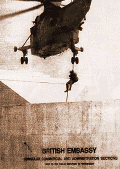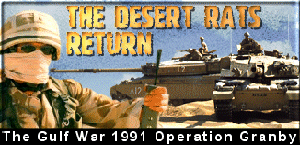SBS Operations

After the Iraqi invasion of Kuwait in 1990, the Special Forces were assigned two possible actions in the emerging Allied contingency plans:
- Rescue of as many Western expatriates as possible from Iraq and Kuwait.
- To stop the Iraqi Scud missiles. Joining the British Special Forces would be the US 5 Special Forces Group, the US SEALs, USAF Special Forces as well as other small groups.
In answer to the first problem, various plans were drawn up all limited and fraught with danger, as the hostages were spread as human shields over Iraq to protect economic and military installations. Three previous examples were available - Saigon 1971, the Israeli raid on Entebbe in 1976 and the US Delta Force raid in 1980, which ended in disaster.
By mid-November, Special Forces command had 800 men from the SAS, SBS and an RAF Special Forces section to join US units for the evacuation raids, although no formal plan had been approved. Helicopter insertion and extraction, and amphibious raids were all considered, but all had risks involved. However, suddenly on 6th December 1990, Saddam Hussein released the hostages and said they would no longer be needed.
This freed the Special Forces for their war role, and they returned to the maps and planning. US Special Forces did front-line reconnaissance. Overall commander, General N. Schwarzkopf, a Vietnam veteran, was not fond of Special Forces, but was quickly turned around when Iraq began test-firing Scud missiles. Mobile Scud launchers presented a target that air power alone could not hit. The possibility remained that Iraq would use biological or chemical warheads in the weapons and launch them at Israel or Saudi Arabia.
The air war began on 17th January, and Scuds were flying before the day was out. To combat the menace of mobile Scud launchers, General Sir Peter de la Billiere persuaded Schwarzkopf to agree to deploy the units of Special Forces command. No amphibious role was assigned to the SBS, instead a line was drawn down the middle of Iraq, with the SAS to the west and the SBS to the east. They were to scout for, locate, and pinpoint mobile Scud launchers.
The SBS sector also contained one vital installation; the junction of a buried mass of fibre-optic cable that provided Iraq with intelligence and front-line reports. The location of the main cable was just 32 miles from Baghdad.
36 men, with barely time for their usual work-up, embarked on two Chinook helicopters from No.7 Squadrons Special Forces Flight and flew into Iraq on 22nd January at night. The 36-man team carried 400 pounds of explosives and was heavily armed, but venturing into an area replete with nomadic Arabs and desert spies, was too close to Iraqi air and ground forces for comfort. The helicopters landed, disengaging their rotors but keeping their engines running to enable a quick escape.
The SBS team quickly located the communications cables and dug down, taking out a length to bring back for analysis, and placed explosives along the exposed area. They retreated and detonated the charge, taking out a 40-yard section of cable. In 90 minutes the SBS had crippled the Iraqi communications grid with no casualties. The lieutenant leading the team grabbed one of the markers for the cable route and presented it to Schwarzkopf on their return.



